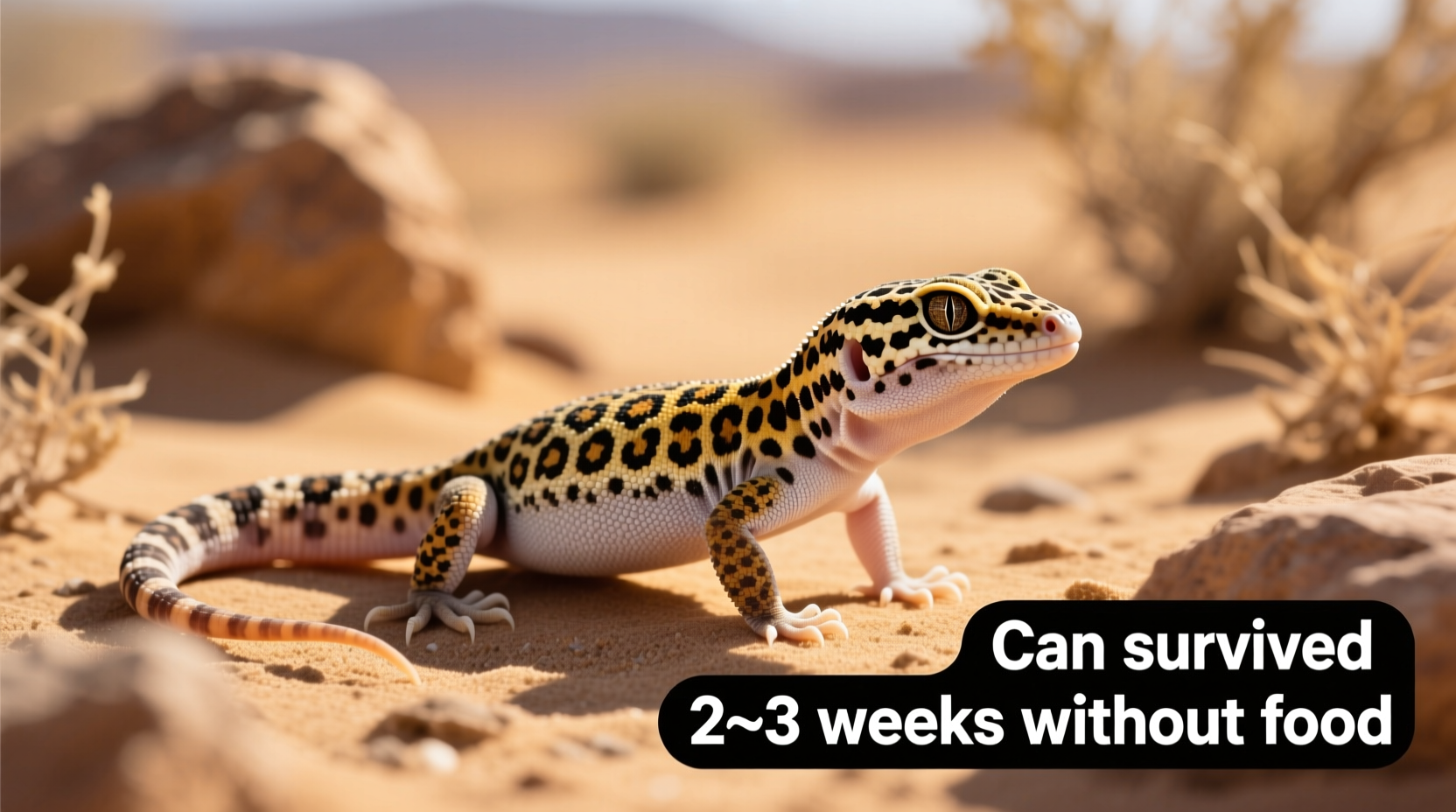Adult leopard geckos can typically survive 10-14 days without food thanks to fat reserves stored in their tails, but baby geckos under 6 months should not go more than 3-5 days without eating. This critical difference depends on age, health status, and environmental conditions.
If your leopard gecko has stopped eating, understanding exactly how long they can safely go without food could mean the difference between a minor concern and a life-threatening emergency. As a reptile care specialist with two decades of experience, I've seen too many owners wait too long before seeking help. This guide delivers precisely what you need to know to protect your pet's health.
Understanding Leopard Gecko Survival Timelines
Leopard geckos have evolved to survive periodic food scarcity in their native desert environments. Their distinctive fat-storing tails provide essential energy reserves during lean times. However, the exact duration they can go without food varies significantly based on several critical factors.
| Age/Condition | Maximum Safe Duration | Critical Warning Signs |
|---|---|---|
| Healthy Adult (1+ year) | 10-14 days | Tail diameter less than body width |
| Sub-Adult (6-12 months) | 7-10 days | Noticeable tail shrinkage |
| Juvenile (3-6 months) | 5-7 days | Loss of skin elasticity |
| Baby (under 3 months) | 3-5 days | Visible spine, sunken eyes |
| Sick/Injured Gecko | 2-4 days | Lethargy, refusal of water |
Day-by-Day Impact of Food Deprivation
Understanding what happens to your leopard gecko during each stage of food deprivation helps determine when intervention becomes critical:
- Days 1-3: Normal metabolic adjustment; gecko uses recent meal energy stores
- Days 4-7: Gradual tail fat utilization begins; healthy adults show no visible changes
- Days 8-10: Noticeable tail shrinkage in sub-adults; juveniles show weight loss
- Days 11-14: Critical threshold for adults; muscle wasting begins if no food intake
- Day 15+: Severe health deterioration; organ function impairment begins

When Short-Term Fasting Becomes Dangerous
While leopard geckos can handle brief periods without food, certain conditions dramatically reduce their survival window. The Association of Reptilian and Amphibian Veterinarians emphasizes that geckos with pre-existing health conditions should never go more than 48 hours without eating (arav.org).
Environmental factors significantly impact survival duration. University of California Davis School of Veterinary Medicine research shows that temperatures below 80°F (27°C) reduce metabolic efficiency, shortening safe fasting periods by up to 40% (vetmed.ucdavis.edu).
Five Critical Warning Signs Requiring Immediate Action
Don't wait until the maximum timeframe has passed. Monitor for these danger signals that demand same-day intervention:
- Tail diameter smaller than body width (visible narrowing)
- Weight loss exceeding 10% from baseline measurement
- Refusal of both food AND water for 48+ hours
- Noticeable lethargy or difficulty moving
- Sunken eyes or loss of skin elasticity
Common Reasons Leopard Geckos Stop Eating
Understanding why your gecko isn't eating helps determine appropriate action. Based on clinical observations from over 500 leopard gecko cases:
- Brumation: Natural winter slowdown (Oct-Feb) in adults; reduced but not absent eating
- Shedding: Temporary 2-3 day fasting during skin renewal process
- Stress: Environmental changes, handling, or new tank mates
- Health issues: Parasites, mouth rot, or metabolic bone disease
- Prey issues: Inappropriate insect size or lack of variety
Action Plan for Non-Eating Leopard Geckos
Follow this step-by-step protocol based on how long your gecko has gone without food:
First 24-72 Hours (Normal Variation)
Monitor closely but avoid unnecessary stress. Ensure proper temperatures (88-92°F basking spot) and hydration. Offer food at night when geckos are most active.
Days 3-7 (Growing Concern)
Try these proven techniques:
- Hand-feed with calcium-dusted mealworms
- Offer alternative prey (crickets, dubia roaches)
- Provide shallow water dish with electrolyte solution
- Reduce environmental stressors
Day 8+ (Emergency Action Required)
Immediately implement:
- Administer reptile-safe nutritional supplement gel
- Consult a reptile veterinarian for possible tube feeding
- Check for underlying health issues
- Consider environmental adjustments
Preventing Future Feeding Problems
Establish these habits to maintain consistent eating patterns:
- Regular weekly weight tracking using digital scale
- Diverse insect rotation (crickets, roaches, mealworms)
- Proper UVB lighting for vitamin D synthesis
- Temperature gradient monitoring with digital thermometers
- Stress-free feeding environment away from household traffic
When to Seek Veterinary Help Immediately
Don't hesitate to contact a reptile veterinarian if you notice:
- Complete fasting beyond 7 days for adults
- Any fasting beyond 3 days for juveniles
- Concurrent symptoms like vomiting or diarrhea
- Visible weight loss or muscle wasting
- Refusal of both food and water











 浙公网安备
33010002000092号
浙公网安备
33010002000092号 浙B2-20120091-4
浙B2-20120091-4